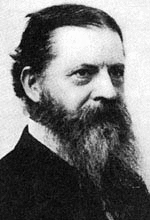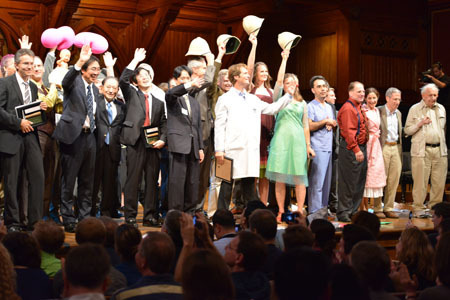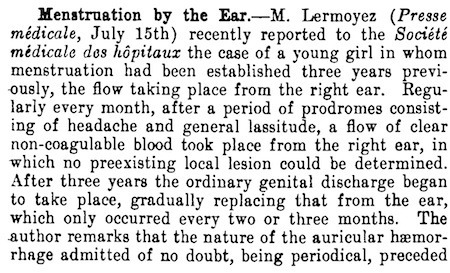Marc Abrahams's Blog, page 445
November 26, 2013
mini-AIR November issue: Uvula, Uvula, Uvula
 The November issue of mini-AIR (our monthly newsletter — it’s a wee little supplement to the magazine) just went out. You can read it online, too. Topics include:
The November issue of mini-AIR (our monthly newsletter — it’s a wee little supplement to the magazine) just went out. You can read it online, too. Topics include:
Uvulopalatopharyngoplasty
Ceramic Uvula Speaker Limerick Competition
Why Do We Have a Uvula?
Pedunculation and the Elongated Uvula
and more
It also has info about upcoming events.
Mel [pictured here] says, “It’s swell.”
mini-AIR is the simplest way to keep informed about Improbable and Ig Nobel news and events. Just add yourself to the mini-AIR list, and mini-AIR will be emailed to you every month.

The Man Behind the Wealthy Dentist
 Jim Du Molin [pictured here] runs a web site called The Wealthy Dentist, and a Wealthy Dentist blog, and also the Wealthy Dentist University.
Jim Du Molin [pictured here] runs a web site called The Wealthy Dentist, and a Wealthy Dentist blog, and also the Wealthy Dentist University.
Jim Du Molin is eager to speak to dental groups, for a fee. Among the things he will talk to them about (for a fee) are:
How to determine your top high-value new patients and calculate your Return-On-Investment (ROI) on each one.
Learn the four critical steps in closing high-value patients How to use the radio to drive a steady stream of of high-value patients to your practice.
Whe
 n and how to get other doctors and health care professionals to refer their high-value patients to you.
n and how to get other doctors and health care professionals to refer their high-value patients to you.If you want Jim Du Molin to come speak to a group of dentists, he wants you to first be aware of these ground rules:
Jim Du Molin speaks for a fee. Please read the following points carefully before requesting Jim’s speaking agreement or calling our office:
Jim has two fee schedules – based on your organization’s attitude about dental speakers promoting their products from the stage.
1. For organizations who frown, disapprove of, or discourage speakers from promoting their services or products from the stage, Jim’s rate is $10,225 a day.
2. For organizations that will allow speakers to promote their services and products in a tasteful, non-confrontational and mannerly way, the fee is $4,500 a day. This includes a sales table in the back of the room where doctors can view samples and place orders.
Jim Du Molin has his own compelling personal story, which he shares in print on his web site.
BONUS: Jim Du Molin wants you to know that he recommends books.

PR Headline of the Week: “Heavy Drinking Is Bad for Marriage if One Spouse Drinks, but Not Both”
This week’s Press Release Headline of the Week waves atop a press release issued by the University of Buffalo. It says:
Heavy Drinking Is Bad for Marriage if One Spouse Drinks, but Not Both
 Beneath the banner lies the story of a breakthrough in the difficult academic field called “Addiction Studies”. The lead researcher, Kenneth E. Leonard [pictured here], get star placement in the press release, where he delivers the dramatic crux:
Beneath the banner lies the story of a breakthrough in the difficult academic field called “Addiction Studies”. The lead researcher, Kenneth E. Leonard [pictured here], get star placement in the press release, where he delivers the dramatic crux:
“This research provides solid evidence to bolster the commonplace notion that heavy drinking by one partner can lead to divorce,” Leonard said. “Although some people might think that’s a likely outcome, there was surprisingly little data to back up that claim until now.”
Details appear in this study:
“Concordant and Discordant Alcohol, Tobacco, and Marijuana Use as Predictors of Marital Dissolution,” Kenneth E. Leonard, Philip H. Smith, Gregory G. Homish, Psychology of Addictive Behaviors, epub Oct 14 , 2013. The authors explain:
“This study examined concordant and discrepant alcohol, tobacco, and marijuana use among couples to determine whether they predicted marital separation or divorce over 9 years. The study recruited 634 couples as they applied for their marriage licenses; we assessed them at that time and reassessed them with mailed questionnaires at their first, second, fourth, seventh, and ninth wedding anniversaries…. The frequency of drinking to intoxication and binge drinking (more than 5 drinks in an occasion) was assessed, as was the use of cigarettes and marijuana. At each assessment, each member of the couple was asked about the occurrence of marital separations and divorce…. discrepant heavy drinking was associated with disruptions, but concordant heavy drinking was not.”
(Thanks to investigator Tim Radford for bringing this to our attention.)

November 25, 2013
Ig Nobel day-after-Thanksgiving broadcast on Science Friday
Spread the word, please! This Friday, November 29, the Science Friday radio program will broadcast its specially edited recording of the 2013 Ig Nobel Prize ceremony. It’s SciFri’s 22nd annual broadcast (SciFri began this day-after-Thanksgiving tradition in 1992, the Ig Nobel ceremony’s second year).
Listen to it on an NPR station, if you’re near one, or on the Internet.
The photo below shows (just!) some of the 2013 Ig Nobel Prize winners, the Nobel laureates who handed out the prizes, the 24/7 Lecturers, and the cast and the medical-all-stars orchestra of the mini-opera ‘The Blonsky Device’. (If you look carefully, you can spot the baby that was born at the thrilling, centrifugal-force-filled conclusion to the opera!). Mike Benveniste took this photo:
BONUS: Science Friday asked journalist Carmen Nobel (yes, that is her name) to visit the Ig Nobel after-party. Her writeup, on the Science Friday site, is called ”Small Talk with Scientists: The Ig Nobel Prize Winners Unwind“.
BONUS: Download your own copy of IgBill, the printed program for the 2013 ceremony, and the 2013 ceremony poster.
BONUS: From SciFri archives, here’s last year (2012)’s Ig Nobel broadcast.
BONUS: The special Ig Nobel 2012 issue of the Annals of Improbable Research

How Not to Poke a Stick at a Machine Gun Bullet
There are many ways to clean a machine gun. Some of those ways are better than the one described in this study:
“Unusual ignition of a bullet causing hand injury: case report,” Abdul Kerim Yapici, Salim Kemal Tuncer, Umit Kaldirim, Ibrahim Arziman, Mehmet Toygar, Injury Extra, epub November 19, 2013. The authors, at Gulhane Military Medical Academy, Ankara, Turkey, report:
“A 35 year–old man was admitted to emergency department with a complaint of injury related to the third web space, third finger pulp and thenar region of right hand. On detailed questioning, he reported that he was cleaning a machine gun (type MG-3) after target practice in a shooting range. He didn’t check visually and physically whether there were any bullets or not in the chamber. The remaining bullet in the chamber was ignited during the cleaning process when he pushed the rod through the barrel (Fig. 1).”
Here is Figure 1 from the study:
BONUS (unrelated): Video of how to fire an MG3, with rock music:

Professorial Pizza Deliveries
 You can probably count on the fingers of fewer than two hands the number of university professors who, as part of their research, have worked for 18 months as pizza delivery operatives. But that is exactly what either* professor Patrick T. Kinkade or* professor Michael A. Katovich of the Sociology and Anthropology Dept. at Texas Christian University, US, did.
You can probably count on the fingers of fewer than two hands the number of university professors who, as part of their research, have worked for 18 months as pizza delivery operatives. But that is exactly what either* professor Patrick T. Kinkade or* professor Michael A. Katovich of the Sociology and Anthropology Dept. at Texas Christian University, US, did.
Their ethnographic research project, which set out to determine if their might be sub-categories to pizza delivery personnel in and around Fort Worth, Texas, found that there are. No less than five distinct subtypes in fact :
“… the comedian, the adventurer, the denier, the fatalist, and the pro. In conclusion, we locate the driver in the context of urban associations where group membership is perceived as or more valuable than monetary rewards and control of time.“
Their paper THE DRIVER: Adaptations and Identities in the Urban Worlds of Pizza Delivery Employees is published in the Journal of Contemporary Ethnography, vol. 25, no. 4, pp 421-448
* Note: The paper doesn’t reveal which.
The picture above is courtesy Professor’s PIZZA, of Watsonia Rd. Melbourne, Australia.
Deliveries start at 5:00 pm.
Delivery charge of A$3.50 applies.
Drivers carry change for A$20.00.
Minimum order for delivery is A$12.00

November 24, 2013
A converter “which appeals to people’s habits for using the toilet”
Habit and hygeine are targeted together in this invention, which converts almost any standard sitting-type toilet to become a squatting-type toilet:
“Novel type externally arranged foldable squatting chair,” Chinese patent #201675851 U, published December 22, 2010. The patent document explains:
“The utility model discloses a novel type externally arranged foldable squatting chair modified from a sitting type closestool through an externally arranged device. The squatting chair comprises a foldable rack (2), a squatting pan (3), and a handrail device (1). The foldable rack (2) can be folded when not used as a flat panel device, the function of which is similar to that of a folded chair. The squatting chair of a U shaped structure of a C shaped structure is provided with anti-skidding devices (4) at both ends to prevent the feet of a toilet user from being hurt. The middle upper part of the rack (2) is provided with the handrail device (1) having a plurality of attached devices (5). Simple in structure, the foldable squatting chair of the utility model can effectively prevents the squatting pan from being contaminated by the excrements of a toilet user; the attached devices arranged on the handrail device also takes full advantage of the available space of the squatting chair, which appeals to people’s habits for using the toilet.”
The device is being manufactured, and is now offered for sale under the brand name ”Sandun-Evaco Toilet Converter”, with the sales slogan “The Best Toilet Converter in The World Today!” Here are photos:
The Sandun-Evaco Toilet Converter web site asks “Have a Fascinating Personal Experience or Story about Squatting?” If you are reading this blog item whilst squatting on a toilet, or sitting on a toilet whilst contemplating squatting, consider telling the fascinating personal details to the Sandun-Evaco Toilet Converter data gatherers.
(Thanks to investigator Erwin Kompanje for bringing this to our attention.)

Bloody, difficult to believe: Menstruation by the Ear
This is one of the few medically documented claims of ear menstruation:
“Menstruation by the Ear, ” New York Medical Journal, August 5, 1899, p. 201.
Here’s the beginning of that report:
(Thanks to the Amboceptor Blog for bringing this to our attention.)

November 23, 2013
Lion manes and human beards
Lion manes and human beards. Human beards and lion manes. Say it as many times and as many ways as you like. Then read this essay, if you have interest in both of those things:
“Of Lion Manes and Human Beards: Some Unusual Effects of the Interaction between Aggression and Sociality,” D. Caroline Blanchard, Frontiers in Behavioral Neuroscience, 2009; 3: 45. The author, at the University of Hawaii at Manoa, writes:
“The function of manes in lions has been a topic of scientific interest since Darwin (1871) suggested that it provides protection in intraspecific fights. Recent experimental studies on wild lions have emphasized the role of female selection, but analyses of specific attack behaviors and targets, and the social consequences of manelessness for lions living in very hot climates suggest that male manes may indeed mitigate the outcomes of intraspecific male attack and thus serve a permissive function for multi-male + female groups, facilitating protection of prides against take-overs and infanticide by nomadic males. Humans also have unusual structural protections for the head, face and neck, areas that are especially accessible during intraspecies attack, and highly vulnerable to damage. One of these, the beard, consists of coarse hairs that grow indefinitely, but only for males, and only during and following puberty; suggesting that it, like the lion’s mane, may serve as protection in intraspecies male fights.”
Here is detail from the study, intended to show the vulnerability to injury of the area covered by a beard or mane:


Dance Your Ph.D.: The 2013 winners, and one that was not chosen
The Dance Your Dissertation competition announced its new winners. John Bohannon, who created and oversees the event, gives details at the Science Now web site. The grand winner is:
Cedric Tan, a biologist at the University of Oxford in the United Kingdom, who finished his Ph.D. there last year with a thesis titled “Sperm competition between brothers and female choice.” His dance interpretation of that research illustrates the chicken mating process using a range of styles, from swing and water ballet—yes, in actual water—to modern jazz and what can only be described as cockfighting.
There were also winners in several categories (chemistry, physics, and social sciences — the “sperm competition” video won the biology category). The scientists and other dancers and technicians who created the videos put in tremendous amounts of care and time.
I was again one of the judges. I’d like to specially (if unofficially) commend one of the physics videos that was not chosen for a prize. Here is Chiara Vitelli‘s “Searching for Schroedinger’s cat: generation and manipulation of multiphoton quantum states“. Before watching it, you might want to read Vitelli’s introduction to the dance, which I have reproduced here, below the video.
Chiara and Silvia perform twin photons with a very special quantum-mechanical property, having no classical analogue. They are “entangled”, in the sense that the properties of Chiara can be inferred probing Silvia, and vice-versa. Specifically, they render their oppositely correlated polarizations by dancing in a specular fashion.
One of the twin photon, Chiara, is amplified by a special crystal generating a bunch of clones. Is the microscopic world (Silvia) still entangled with the macroscopic world represented by the new family of Chiara’s clones? The question is a critical one, since this micro-macro entanglement is the very essence of a Schroedinger’s cat, where the quantum state of an atom (the microscopic world), once probed, rules the fate of the cat (the macroscopic world). This is the celebrated paradox named after Schroedinger.
Unfortunately, quantum cloning is not as simple and smooth as xeroxing. Among several Chiaras, some Silvia-like photons always come out from the amplification. Requiring some arbitrary criterion to identify the correct multi-photon state. A clever filter does the job, asking at least two specific performances to the cloned family in order to test the micro-macro entanglement. Oscillation-based and rotation-based movements represent two possible ways of measuring polarization. After each performance the filter counts the copies moving like Chiara and those moving like Silvia. When sufficiently unbalanced, i.e. more Chiaras than Silvias, he approves the state, else he rejects it.
The two successful measurements achieved by the filter are suggestive of the entangled nature between the microscopic (Silvia) and the macroscopic state (cloned Chiaras).
As any groundbreaking scientific discovery, several years later a lively debate still stands…
References:
1. Francesco De Martini, Fabio Sciarrino and Chiara Vitelli, ”Entanglement Test on a Microscopic-Macroscopic System” Phys. Rev. Lett. 100, 253601 (2008). link.aps.org/doi/10.1103/PhysRevLett.100.253601
2. Chiara Vitelli, Nicolò Spagnolo, Lorenzo Toffoli, Fabio Sciarrino, and Francesco De Martini, ”Quantum-to-classical transition via fuzzy measurements on high-gain spontaneous parametric down-conversion” Phys. Rev. A 81, 032123 (2010)link.aps.org/doi/10.1103/PhysRevA.81.032123
3. Chiara Vitelli, Nicolò Spagnolo, Lorenzo Toffoli, Fabio Sciarrino, and Francesco De Martini, “Enhanced Resolution of Lossy Interferometry by Coherent Amplification of Single Photons” Phys. Rev. Lett. 105, 113602 (2010)link.aps.org/doi/10.1103/PhysRevLett.105.113602
BONUS: Several years ago, one of the Dance Your Dissertation competition winners, Miriam Sach, performed as part of the Improbable Research session at the AAAS Annual Meeting (which that year was held in San Diego). Perhaps, perhaps one of the new winners will perform at the the Improbable Research session at the upcoming AAAS Annual Meeting, in Chicago, on Saturday night, February 15, 2012.

Marc Abrahams's Blog
- Marc Abrahams's profile
- 14 followers








